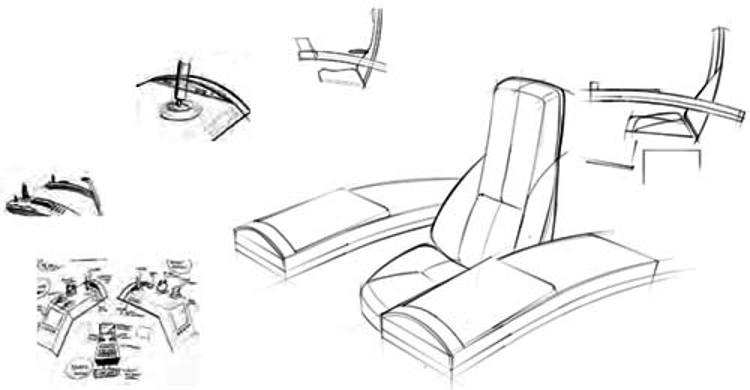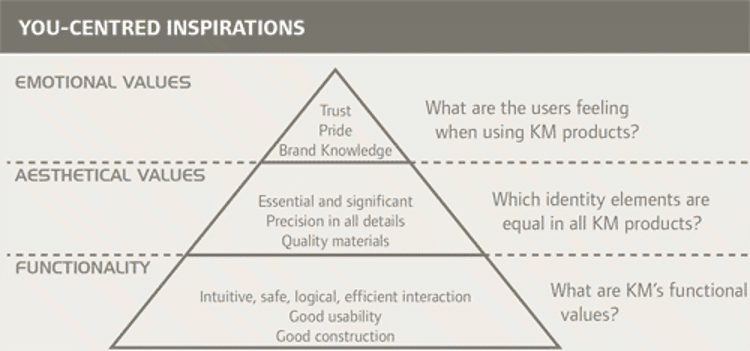You-Centred Design
-- FROM THE FULL PICTURE MAGAZINE -- Technology and functionality have a way of growing. Unfortunately this trend doesn't always benefit the user. Kongsberg Maritime is working to ensure that users' needs are at the heart of new technology development. Here's how we are doing it.
Simplification. If you had to boil down much of the work going on these days in product development at Kongsberg Maritime into one word, that would be it. We're talking about simplification akin to the iPhone – that is, the products may not be simple, but they should feel simple and be intuitive to operate.

Innovative within a conservative industry
"We're trying to be innovative within a conservative industry," says Kongsberg's Thor Hukkelås, who has led the company's cutting-edge work on K-Master and user-centred design. It is very important to be on the same team as the classification societies. Kongsberg Maritime has worked closely with DNV-GL to expand the scope for meeting rules, and even for promoting changes in rules. "K-Master challenged class quite a bit. We studied the notes for aft bridge operations, called NAUT-OSV, very carefully, and challenged areas, when we felt it was necessary. We had a very positive dialogue with DNV-GL, which resulted in the approval of many of the suggestions for design changes that we had," says Hukkelås.
A user-centred designer on putting you in the centre
It's important to note that user-centred design isn't a new technology; it's a philosophy, and a new way of thinking about tasks.
In Designing for Situational Awareness, here's what Endsley, Bolte and Jones have to say:
"Document what information operators need to perform their job and how the operator integrates or combines information to address a particular decision."
The Full Picture asked Hukkelås for his comments describing how user-centred design works. Here's what he said:
"Simplicity is at the heart of what we're trying to achieve. We are constantly trying to strip down functionality to what is really needed instead of adding more and more 'nice to have' functions. We focus on the 20 percent of the functions that are used 80 percent of the time.
"Today's situation is such that there's a large gap between the vast amount of data that is produced and presented to the user, and the information that is really needed by the user. We are trying to close this information gap by designing systems for maximum Situational Awareness (SA).
"Basically, SA is being aware of what is happening around you and understanding what that information means to you now and in the future. Systems designed to achieve maximum SA support decision making and thus increase the performance of the user.
"We are trying to change the focus from boxes, systems and equipment to function, information and operation.
"In an alarm scenario, for example, your first task must be to bring the operator's heart rate down, make him or her feel like he or she is in control of the situation.
"All computerised systems have a tendency to grow and gain functions until you lose sight of the main task that is supposed to be supported.
"We're focusing on adapting user functions to their operational context and building functionality across traditional bridge activities in order to support the operation that the vessel is built for. We think about what is actually needed to support the vessel as a tool for performing, for example, an anchor-handling operation.
"Anyone who has worked with software development has seen that user interaction and the human-machine interface is tacked on at the end of the process. We're trying to include it from the start of the design process.
"Onboard computer systems are designed today to present information or provide control. I believe the next wave of systems will support decisions.
"There's a spiral of development where the user is in the centre all the way: We design a little, build a little, test a little and learn a lot."

What’s wrong, what can be done and what will look better from the user’s perspective
| What’s wrong with the current situation | What can be done to improve the situation | What will a better situation look like |
| Users are flooded with too much information, and lose mastery over the situation. | Incoming signals and information are combined in more intuitive graphic user interfaces (GUI). | Users can obtain an understanding of the situation at a glance and query the system where necessary. |
| Users need to criss-cross the bridge consulting screens to create a cohesive picture of the situation. | Traditional stand-alone systems are brought together in one unified operator interface, accessible at multiple points. | Users can get what they need in one place, or from any place with a display. |
| In an alarm situation, many buttons and indicators start flashing. Heartbeats race, without a sense of what can be done. | Design of systems should strive to bring down the heartbeat of the user in an alarm situation. | Rather than presenting problems, an operating system presents a diagnosis and a few courses of action to redress the situation. |
| Technology is built around what is possible, not around what users want or need. | Take the product design focus on human-machine interface from something done at the end of the process, to something done at the start. | Consoles provide what the user wants and needs, with as much functionality as they might need under the covers. |
| technology is not, or is hardly, used until it is sold to its first customer, and that customer takes it into operation. | New interfaces are developed rapidly, tested against real users, and redeveloped if needed – prior to first customer delivery. | A technology has demonstrated its user-friendliness and performance through several iterations before a customer starts using it. |
| The number of systems and sensors effectively hide the current status of the ship from the operator. | Systems are created to provide users with an accurate picture of the ship’s status. | Users have an immediate understanding of the state of the ship, and get support for future decision-making. |
Feedback from users
The first step in the design process is understanding the user. Kongsberg Maritime undertook numerous interviews with users of advanced operational systems. Here's an example of some of their feedback.
Keeping it Simple
Feedback from a user on DPS 112, the new Kongsberg Seatex GPS-based position reference system: "The system has the good looks of a high-end audio product and beauty is not skin deep for when you turn it on the enjoyment continues. "The menus and graphics are simple, easy to navigate and graphically impressive. "Like a star NFL quarterback, the 112's good looks come with seemingly effortless performance." Feedback from a user when he saw eBird for the first time: "You see that it will work just by looking at it." "It is not a secret that my favourite Dynamic Positioning Systems manufacturer is Kongsberg Maritime. Why? Because, despite the fact that their DP Systems run off common Windowsbased desktop computers, they aspire to the Apple model of good design, intuitive graphic interfaces and reliability. Their systems just work."
Information
"Information is key. The more we know, the better we can control it." "No information is dangerous."
Emergency shutdown systems and Fire & Gas systems
"ESD is horribly confusing on drillships. We need a visual presentation." "ESD is scary – better not to touch it." "Emergency teams mark up a GA drawing to mark temperatures and know what's been done. 3D could be faster."
Alarms
"Audio alarms are distracting and tiring. Loud noises lead to irritated and angry operators." "When the screen is filled up with alarms, the operator just has to pick out some using gut instinct."
Human-Machine Interface (HMI)
"Today there are too many buttons and too much text." "I have trouble with reading text in stressful situations. It must be self-explanatory." "Use pictures instead. We think with our spine." "We don't read manuals."
A dream solution
"Like an iPhone. It must be easy to navigate." "See 3D with ducts and valves, like CSI." "Automatic is always good – when it works." "Remove all the trash and keep it simple."